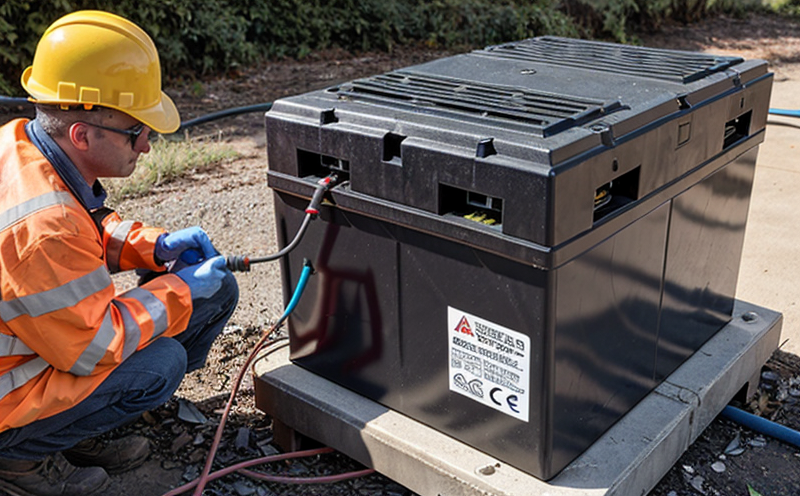UL 1989 Lead-Acid Battery Safety and Performance Testing
The UL 1989 standard for lead-acid batteries is a comprehensive set of requirements designed to ensure the safety, performance, and reliability of these batteries. This standard covers a wide range of tests that must be conducted on various types of lead-acid batteries used in automotive, industrial, and stationary applications.
Compliance with UL 1989 is essential for manufacturers looking to meet regulatory requirements and ensure their products are safe and reliable before entering the market. This standard ensures that batteries perform consistently under specified conditions and comply with strict safety criteria. The tests outlined in this standard help verify that the battery can withstand various environmental stresses, such as temperature extremes, vibration, and overcharging.
The testing process begins with careful specimen preparation, which includes charging the battery to a full state of charge according to specific protocols detailed in the UL 1989 specification. Once prepared, the battery undergoes a series of tests designed to evaluate its safety and performance characteristics. These tests include voltage measurements during various operational conditions, thermal stability checks, cyclic endurance trials, and short circuit tests.
During these tests, advanced instrumentation is used to monitor critical parameters such as internal resistance, temperature, and voltage fluctuations. The data collected from these instruments is then analyzed to determine whether the battery meets the stringent requirements set forth by UL 1989. If any discrepancies are found during testing, corrective actions must be taken until all specifications are met.
The industry has recognized the importance of meeting UL 1989 standards for lead-acid batteries due to their widespread use in critical applications like uninterruptible power supplies (UPS), electric vehicles, and backup systems. Meeting these requirements not only enhances safety but also builds consumer trust by ensuring high quality and reliability.
The following table summarizes the key tests performed under UL 1989:
| Test Description | Parameters Measured |
|---|---|
| Voltage Stability Test | Open circuit voltage, float voltage, equalization voltage |
| Cyclic Endurance Test | Cycle count, state of charge (SOC), internal resistance |
| Short Circuit Protection Test | Circuit protection response time, short circuit current |
| Vibration and Shock Test | Voltage variation during test, structural integrity |
In addition to these tests, UL 1989 also specifies requirements for labeling and packaging of the batteries. Proper identification and clear instructions on usage are crucial for ensuring user safety.
The testing process is highly technical and involves specialized knowledge and equipment. Our team of experts ensures that every step of the process adheres strictly to the requirements outlined in UL 1989. By providing accurate, reliable test results, we help our clients make informed decisions about their product development and quality control processes.
Benefits
- Ensures compliance with international safety standards
- Improves battery reliability in critical applications
- Builds trust among consumers through consistent performance
- Aids in regulatory approval processes
- Supports continuous improvement of product design and manufacturing practices
- Promotes safer handling and usage by end-users
- Reduces the risk of recalls or product liability issues
Industry Applications
UL 1989 lead-acid battery testing is widely used across various industries where reliability and safety are paramount. Here’s a breakdown of some key applications:
| Industry Sector | Main Use Cases |
|---|---|
| Automotive | Engine starting, emergency lighting systems |
| Telecommunications | Backup power for telecom towers |
| Data Centers | UPS systems to ensure uninterrupted data processing |
| Backup Power Systems | Providing continuous power during outages |
| Electric Vehicles | Powering the batteries for electric vehicle operation |
The rigorous testing procedures outlined in UL 1989 help ensure that lead-acid batteries perform reliably and safely in these diverse environments.





